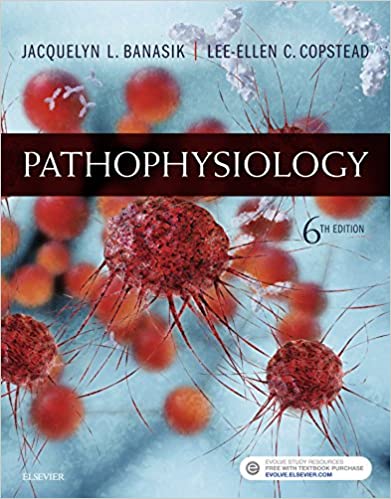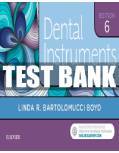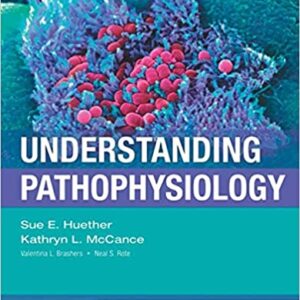Test bank for Pathophysiology 6th Edition By Banasik
Chapter 01: Introduction to Pathophysiology
MULTIPLE CHOICE
1. C.Q. was recently exposed to group A hemolytic Streptococcus and subsequently developed a pharyngeal infection. His clinic examination reveals an oral temperature of 102.3F, skin rash, dysphagia, and reddened throat mucosa with multiple pustules. He complains of sore throat, malaise, and joint stiffness. A throat culture is positive for Streptococcus, and antibiotics have been prescribed. The etiology of C.Q.’s disease is
a. a sore throat.
b. streptococcal infection.
c. genetic susceptibility.
d. pharyngitis.
ANS: B
Etiology refers to the proposed cause or causes of a particular disease process. A sore throat is the manifestation of the disease process. Genetic susceptibility refers to inherited tendency to develop a disease. Pharyngitis refers to inflammation of the throat and is also a
clinical manifestation of the disease process.
2. A 17-year-old college-bound student receives a vaccine against an organism that causes
meningitis. This is an example of
a. primary prevention.
b. secondary prevention.
c. tertiary prevention.
d. disease treatment.
ANS: A
Primary prevention is prevention of disease by altering susceptibility or reducing exposure
for susceptible individuals by providing vaccination. Secondary prevention is the early
detection, screening, and management of the disease. Tertiary prevention includes
rehabilitative and supportive care and attempts to alleviate disability and restore effective
functioning. Disease treatment involves management of the disease once it has developed.
3. An obese but otherwise healthy teen is given a prescription for a low-calorie diet and
exercise program. This is an example of
a. primary prevention.
b. secondary prevention.
c. tertiary prevention.
d. disease treatment.
ANS: B
Secondary prevention is the early detection, screening, and management of the disease such
as prescribing diet and exercise for an individual who has already developed obesity.
Primary prevention is prevention of disease by altering susceptibility or reducing exposure
for susceptible individuals. Tertiary prevention includes rehabilitative and supportive care
and attempts to alleviate disability and restore effective functioning. Disease treatment
involves management of the disease once it has developed.
Pathophysiology 6th Edition Banasik Test BankNU
4. A patient with high blood pressure who is otherwise healthy is counseled to restrict sodium
intake. This is an example of
a. primary prevention.
b. secondary prevention.
c. tertiary prevention.
d. disease treatment.
ANS: B
Secondary prevention is the early detection, screening, and management of the disease, such
as by prescribing sodium restriction for high blood pressure. Primary prevention is
prevention of disease by altering susceptibility or reducing exposure for susceptible
individuals. Tertiary prevention includes rehabilitative and supportive care and attempts to
alleviate disability and restore effective functioning. Disease treatment involves
management of the disease once it has developed.
5. After suffering a heart attack, a middle-aged man is counseled to take a cholesterol-lowering
medication. This is an example of
a. primary prevention.
b. secondary prevention.
c. tertiary prevention.
d. disease treatment.
ANS: C
Tertiary prevention includes rehabilitative and supportive care and attempts to alleviate
disability and restore effective functioning such as prescribing a cholesterol-lowering
medication following a heart attack. Primary prevention is prevention of disease by altering
susceptibility or reducing exposure for susceptible individuals. Secondary prevention is the
early detection, screening, and management of the disease. Disease treatment involves
management of the disease once it has developed.
6. A patient has been exposed to meningococcal meningitis, but is not yet demonstrating signs
of this disease. This stage of illness is called the _____ stage.
a. prodromal
b. latent
c. sequela
d. convalescence
ANS: B
Incubation refers to the interval between exposure of a tissue to an injurious agent and the
first appearance of signs and symptoms. In infectious diseases, this period is often called the
incubation (latent) period. Prodromal refers to the appearance of the first signs and
symptoms indicating the onset of a disease. These are often nonspecific, such as headache,
malaise, anorexia, and nausea, which are associated with a number of different diseases.
Sequela refers to subsequent pathologic condition resulting from a disease. Convalescence is
the stage of recovery after a disease, injury, or surgical operation.
7. A disease that is native to a particular region is called
a. epidemic.
b. endemic.
Pathophysiology 6th Edition Banasik Test BankNU
c. pandemic.
d. ethnographic.
ANS: B
A disease that is native to a particular region is called endemic. An epidemic is a disease
that spreads to many individuals at the same time. Pandemics are epidemics that affect large
geographic regions, perhaps spreading worldwide.
8. In general, with aging, organ size and function
a. increase.
b. decrease.
c. remain the same.
d. are unknown.
ANS: B
In general, with aging, organ size and function decrease.
9. The stage during which the patient functions normally, although the disease processes are
well established, is referred to as
a. latent.
b. subclinical.
c. prodromal.
d. convalescence.
ANS: B
The stage during which the patient functions normally, although the disease processes are
well established, is called the subclinical stage. The interval between exposure of a tissue to
an injurious agent and the first appearance of signs and symptoms may be called a latent
period or, in the case of infectious diseases, an incubation period. The prodromal period, or
prodrome, refers to the appearance of the first signs and symptoms indicating the onset of a
disease. Convalescence is the stage of recovery after a disease, injury, or surgical operation.
MULTIPLE RESPONSE
1. Your patient’s red blood cell is slightly elevated today. This might be explained by (Select
all that apply.)
a. gender difference.
b. situational factors.
c. normal variation.
d. cultural variation.
e. illness.
ANS: A, B, C, E
Gender, situations (e.g., altitude), normal variations, and illness may all determine red blood
cell count. Culture affects how manifestations are perceived (normal versus abnormal).
2. Socioeconomic factors influence disease development because of (Select all that apply.)
a. genetics.
b. environmental toxins.
c. overcrowding.
NURSINGTB.COM
Pathophysiology 6th Edition Banasik Test BankNU
d. nutrition.
e. hygiene.
ANS: B, C, D, E
Socioeconomic factors influence disease development via exposure to environmental toxins
(occupational) and overcrowding, nutrition (over- or undernutrition), and hygiene (e.g., in
developing countries). Genetics is not influenced by socioeconomic factors.
TRUE/FALSE
1. When the cause is unknown, a condition is said to be idiopathic
ANS: T
Many diseases are idiopathic in nature.
2. The nurse is swabbing a patient’s throat to test for streptococcal pharyngitis. The nurse must
understand that tests such as this differ in the probability that they will be positive for a
condition when applied to a person with the condition; this probability is termed sensitivity.
ANS: T
The sensitivity of any test refers to the probability that the test will be positive when applied
to a person with the condition and will not provide a false negative result. In contrast,
specificity is the probability that a test will be negative when applied to a person who does
not have a given condition.




